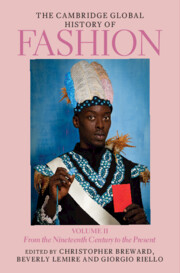Book contents
- The Cambridge Global History of Fashion
- The Cambridge Global History of Fashion
- The Cambridge Global History of Fashion
- Copyright page
- Contents for Volume II
- Figures for Volume II
- Maps for Volume II
- Table for Volume II
- Contributors for Volume II
- Preface
- Part IV Fashion, Modernism, and Modernity
- Part V Fashion, Colonialism, and Post-Colonialism
- 29 Chinese Coolie Hats
- 30 Crumbling Empires and Emerging Nations
- 31 Gender, Nation, Fashion, and Modernities in the Asia-Pacific, 1900 to the Present
- 32 The Global Politics of Wearing, Buying, and Selling European-Style Dress, c. 1900–1930
- 33 Fashioning Diasporas
- 34 Colonial Fashion Histories
- Part VI Fashion Systems and Globalization
- Index
- References
34 - Colonial Fashion Histories
from Part V - Fashion, Colonialism, and Post-Colonialism
Published online by Cambridge University Press: 04 August 2023
- The Cambridge Global History of Fashion
- The Cambridge Global History of Fashion
- The Cambridge Global History of Fashion
- Copyright page
- Contents for Volume II
- Figures for Volume II
- Maps for Volume II
- Table for Volume II
- Contributors for Volume II
- Preface
- Part IV Fashion, Modernism, and Modernity
- Part V Fashion, Colonialism, and Post-Colonialism
- 29 Chinese Coolie Hats
- 30 Crumbling Empires and Emerging Nations
- 31 Gender, Nation, Fashion, and Modernities in the Asia-Pacific, 1900 to the Present
- 32 The Global Politics of Wearing, Buying, and Selling European-Style Dress, c. 1900–1930
- 33 Fashioning Diasporas
- 34 Colonial Fashion Histories
- Part VI Fashion Systems and Globalization
- Index
- References
Summary
On 2 March 1940, A Grand Big Show Competition DANCE, featuring ballroom dance champions from clubs in several Copperbelt towns was held in the Railway Compound in the zinc and lead mining town, Broken Hill (today Kabwe), in what was then the British Protectorate of Northern Rhodesia (today Zambia). As was common at such events, European residents were invited to watch and to judge both the dancing and the dress. At this particular dance competition, British anthropologist Godfrey Wilson, who was conducting research on the town’s African urbanization, had invited along his wife, South African born anthropologist Monica Wilson. An astute observer with an unusual flair for African preoccupations with dress, Godfrey Wilson asked her to ‘cover the frocks’, as she noted in a letter to her father in South Africa. Looking after their new-born baby and assisting her husband in a variety of ways, she told her father that ‘it was so nice to be doing “field work” again’. Aside from emphasizing the ‘intense desire’ of Africans in Broken Hill for clothing and calculating their expenditures, Wilson himself provided little detail about their evolving dress practices.
- Type
- Chapter
- Information
- The Cambridge Global History of FashionFrom the Nineteenth Century to the Present, pp. 1190 - 1218Publisher: Cambridge University PressPrint publication year: 2023



